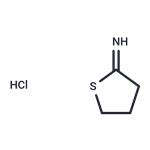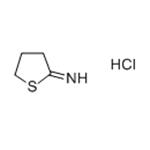Chemical Properties
White Crystalline Solid
Uses
2-Iminothiolane hydrochloride is predominantly used as an amine reactive at pH 7-10 and is also an effective thiolation reagent for polysaccharides. It is also used as a RNA-protein crosslinking reagent as well as useful in cross-linking proteins..
Uses
Cross-linking reagent cleavable by thiols.
Uses
2-Iminothiolane hydrochloride is a valuable tool in studies of cellular organelles and oligomeric enzymes, using the techniques of protein-protein cross-linking. It may also be used to introduce reactive sulfhydryl groups into proteins for subsequent reaction with alkylating agents or heavy metal compounds.
General Description
2-Iminothiolane hydrochloride (2-IT.HCl), a protein modification reagent, is commonly employed to attach thiol groups to proteins and peptides. Raman spectroscopic analysis of hair keratin fibers modified with 2-IT.HCl showed the formation of new disulfide groups.
Purification Methods
Recrystallise the hydrochloride from MeOH/Et2O (m 187-192o) or (MeOH/Me2CO), but after sublimation at ~180o/0.2mm the melting point rises to 202-203o. It has 1HNMR with 2.27 (2H, t), 3.25 (2H, t) and 3.52 (2H, t) in (CD3)2SO. [King et al. Biochemistry 17 1499 1978.] The free base is purifed by vacuum distillation (b 71-72o/6mm) with IR (film) with 1700 (C=N)cm-1 and 1HNMR (CDCl3) with at 3.58 (2H, t) and max 2.10-2.8 (4H, m). The free base is stable on storage but slowly hydrolyses in aqueous solutions with half-lives at 25o of 390hours at pH 9.1, 210hours at pH 10 and 18hours at pH 11. [Traut et al. Biochemistry 12 3266 1973, Biochemistry 17 399 1978, Alagon & King Biochemistry 19 4343 1980, Beilstein 17/9 V 12.]



